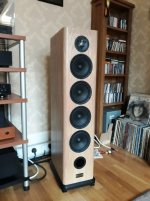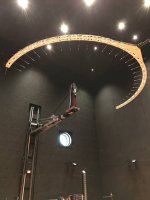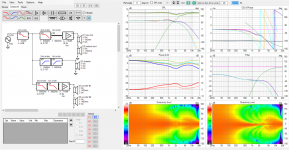As I told Allen, it comes down to different priorities, and here they are quite different from the usual fare. Also, I would expect that 'fixing' one problem may actually make something else worse. Later I will provide in-room 1/6th octave pink noise RTA measurements. Then everybody can judge if they find it acceptable or not. Note that the waveguide gives a major advantage here and also that unlike other low-order designs that have generally 50% vector summing (Butterworth filters), this is not the case here. Not like Duntech and Dunlavy designs. I actually computer-modeled the Duntech Sovereigns, only two persons have done that, you know who the other one was. Some shockers there, one that I am not allowed to tell. 
I suspect it will be better than you think. Previous Mk5 and Mk6 designs did OK, have you heard them?
I am much more focussed on what happens on the electrical side, not just acoustically.
BTW, do you have a real name?
I suspect it will be better than you think. Previous Mk5 and Mk6 designs did OK, have you heard them?
I am much more focussed on what happens on the electrical side, not just acoustically.
BTW, do you have a real name?
Of course, every project has its strengths and weaknesses. Here we have two, lower midbasses, which according to measurements are filtered from 2kHz. The problem is that these drivers are actually at the floor and there is no chance to keep a fairly even dispersion of sound in the vertical axis. This way of radiating sound can significantly affect the presentation of the apparent sound sources, their size and placement on the "stage".
Measuring RTA in a room will not reveal much here because it will be affected by room reflections. In my opinion, such projects should be designed based on more accurate measurements of the spinorama, especially since we now have the tools and software to use it. Electrically, the measurements look excellent and there is no doubt about that.
With the current software available to amateurs, I see no problem in simulating a model of speakers like the Dunlavy.
I have not listened to the previous Mk5 and Mk6.
Of course I have a real name, I'm not a robot, but using a nickname on the forums is quite normal?
mV8 vel Lukasz
Measuring RTA in a room will not reveal much here because it will be affected by room reflections. In my opinion, such projects should be designed based on more accurate measurements of the spinorama, especially since we now have the tools and software to use it. Electrically, the measurements look excellent and there is no doubt about that.
With the current software available to amateurs, I see no problem in simulating a model of speakers like the Dunlavy.
I have not listened to the previous Mk5 and Mk6.
Of course I have a real name, I'm not a robot, but using a nickname on the forums is quite normal?
mV8 vel Lukasz
I think what Joe is trying to politely say is that he and most Elsinore builders aren't very interested when people say that such projects 'should' be designed based on whatever method they, or anybody else for that matter might happen to prefer. He has his own priorities, is well aware of the balance of advantages and tradeoffs involved, and is quite happy with them.
Perhaps he and Elsinore builders don't actually care.
It's very easy to get wrapped up in one's own priorities, while forgetting that it will not be universally admitted that everybody else is obliged to share them. The attached is a 4x midbass + tweeter design I did a few years back for example -very different conceptually to the Elsinores other than the number of drivers, because I had different objectives. Do I think the Elsinores should be like it, or share the same design priorities though? No. I think they should be as Joe wants them to be. I may be mistaken, but I don't recall him asking for advice or opinions on how to change them.
It's very easy to get wrapped up in one's own priorities, while forgetting that it will not be universally admitted that everybody else is obliged to share them. The attached is a 4x midbass + tweeter design I did a few years back for example -very different conceptually to the Elsinores other than the number of drivers, because I had different objectives. Do I think the Elsinores should be like it, or share the same design priorities though? No. I think they should be as Joe wants them to be. I may be mistaken, but I don't recall him asking for advice or opinions on how to change them.
Attachments
My comment pointed out that today, using the same tools, you can get much more information about how the speakers in a given design radiate to their environment, and thus you can design the crossover more accurately. Of course, this is Joe's design and he does it the way he thinks is best. I'm just using the right/opportunity to make a comment that may be of interest to Joe or someone else to take the next step forward on the road to more and better designs.
Your speakers look very nice, but what more can one say without seeing their detailed design and most importantly precise measurements?
Your speakers look very nice, but what more can one say without seeing their detailed design and most importantly precise measurements?
Indeed. And again, one needs to be careful when assuming that others are ignorant of differing approaches, rather than considering the fact that it may just not be a priority or even an interest for them, or that their crossover is already designed 'accurately' according to their design priorities. In this case, Joe has already explained he is satisfied with his general approach and filter, notwithstanding some probable adjustments based on listening & test data from his prototypes. QED.
Re my old speaker design, as noted, I mentioned it for the sole purpose of illustrating the point that different people can come up with very different designs on a vaguely similar theme without implying (or even thinking) that their criteria or methodologies are superior or that others 'should' (!) adopt them. There is nothing for anybody else to say on the matter, since they were not a shared project, and achieved the measured and subjective criteria I had for them. I'm glad you think they look nice though -my then cabinet-building partner-in-crime, for whom they were designed, did some beautiful work.
Re my old speaker design, as noted, I mentioned it for the sole purpose of illustrating the point that different people can come up with very different designs on a vaguely similar theme without implying (or even thinking) that their criteria or methodologies are superior or that others 'should' (!) adopt them. There is nothing for anybody else to say on the matter, since they were not a shared project, and achieved the measured and subjective criteria I had for them. I'm glad you think they look nice though -my then cabinet-building partner-in-crime, for whom they were designed, did some beautiful work.
That measuring with ANSI-CTA-2034 and generating a spinorama is a much more advanced and accurate method of measurement is not in dispute. That Joe uses an older method of measurement but one that is sufficient for him is another matter entirely. Everyone must decide for themselves what accuracy they need and what they want to see on their measurements. That is all.
Joe will undoubtedly clarify, but the lower drivers include additional filtering to cut them off well before 2kHz. The previously posted crossover designs will show his elegant solution for you.Of course, every project has its strengths and weaknesses. Here we have two, lower midbasses, which according to measurements are filtered from 2kHz. The problem is that these drivers are actually at the floor and there is no chance to keep a fairly even dispersion of sound in the vertical axis...
With such a high cross over point, a gentle filtering, and a long distance between the sound sources, the radiation in the vertical axis will be quite distorted. This would be clearly visible on a spinorama measurement.

..would you do this if your loudspeaker's verticals look like crap beyond a total of 15 degrees? I wouldn't, most particularly because 98% of loudspeakers ALSO HAVE THIS PROBLEM.
BTW, spinorama? Really? Just a reasonable range of vertical data would "do" it. The whole "must-have spinorama data" is Klippel-snobishness. (..which what, all of 2 DIY'ers have access to?) Or maybe everyone should have access to an anechoic chamber that goes to at least 80 Hz and are willing to do 70+ measurements under exceedingly controlled conditions to meet that CEA-2034 requirement?
this kind of question/debate occurred several times previously where the one who kept asking had no intention to build it. just to glorify his knowledge for meaningless point.That's why I'm waiting for the official and final version of the crossover.
anyway, what Joe did for Elsinore is for freeeeeeeeo, you can take Joe's approach or leave it and do your own design
in a matter of big company measurement method, i find what Dynaudio does in their room looks amazing
http://peteswrite.blogspot.com/2018/05/dynaudio-factory-visit.html?m=1
once I visited anechoic room in my previous university which has 120m2 floor area and maybe more than 15m height. but their purpose is more for testing material acoustic properties instead of audio source testing
all of my friends that i invited to join that visit have their own local brand loudspeaker, i give them an access to anechoic chamber so hopefully oneday they can have a proper measurement.
Attachments
..would you do this if your loudspeaker's verticals look like crap beyond a total of 15 degrees? I wouldn't, most particularly because 98% of loudspeakers ALSO HAVE THIS PROBLEM.
BTW, spinorama? Really? Just a reasonable range of vertical data would "do" it. The whole "must-have spinorama data" is Klippel-snobishness. (..which what, all of 2 DIY'ers have access to?) Or maybe everyone should have access to an anechoic chamber that goes to at least 80 Hz and are willing to do 70+ measurements under exceedingly controlled conditions to meet that CEA-2034 requirement?
So you're saying that most speakers have midbass drivers at the floor, cut at 2kHz? I don't think so.
To have an idea of Power Response, Directivity Index, or predicted In room response you don't have to buy a Klippel right away, and you don't have to make measurements in an anechoic chamber.
How do you know I have no desire to build a project Joe? I merely pointed out the measurement issue, and so far I'm under attack because of it.this kind of question/debate occurred several times previously where the one who kept asking had no intention to build it. just to glorify his knowledge for meaningless point.
It is not too hard to do measurements for CTA data at home even though the few posts here try to convey that it was. Any other hobbyist measurements are done at home as well and the measurement accuracy is same. Taking "spinorama" is just more measurements, more data, more complete picture what the speaker outputs and the accuracy is greater to single axis measurement for design purposes, but if someone doesn't want to use more data it is fine. If designer has experience then there is possibility to save time and take only the measurements needed.
It feels counter intuitive though to skip more data since it is very small investment in comparison to a whole project, few more hours of time to spin it, then learn how to use the data in simulator will take more time but his is one time expense. In the end main thing is to have fun with the hobby. If it is commercial endeavor then there is crowd that pays for products that have the data and another crowd that likes to read adjectives instead. Both can buy products they like.
It feels counter intuitive though to skip more data since it is very small investment in comparison to a whole project, few more hours of time to spin it, then learn how to use the data in simulator will take more time but his is one time expense. In the end main thing is to have fun with the hobby. If it is commercial endeavor then there is crowd that pays for products that have the data and another crowd that likes to read adjectives instead. Both can buy products they like.
as i mentioned previously, this is not the first time happen and i dont attack you, I protect JoeuHow do you know I have no desire to build a project Joe? I merely pointed out the measurement issue, and so far I'm under attack because of it.
you can read maybe afterpage 150 where Joe was attacked even by admin on this site and other users too.
let's ended there, Joe already answere your method that he will not use, let's end it there.
if you keep asking again, i'm sure you'll get responses that you might consider as being attacked
Please, no inversions, especially not those heading in the direction of straw-men. You are not under 'attack'. If you were under 'attack', you would know about it, and so would everyone else because the moderation team would have stepped in to address matters. They are most efficient at doing so. In point of fact, there have been no personal insults, abuse, persecution or anything of the kind directed toward you: merely some civil disagreement, with a hint of wry humour, which is unlikely to cause grown men to swoon, women to tear their hair, and urchins to weep in the streets.How do you know I have no desire to build a project Joe? I merely pointed out the measurement issue, and so far I'm under attack because of it.
To put it as clearly as possible, and in the friendliest possible spirit, you don't seem to have quite understood that Joe & most of those interested in the Elsinore have heard all this (and more) before, and aren't all that interested in your opinion on the design or measurement methodology. Critiques and alternate perspectives are valuable things of course, but once they have been expressed, and the relevant parties have either adopted or rejected them as the case may be, it is courteous to accept that fact. As has been noted, if you prefer something else, you are of course free to develop a different project of your own via whatever methodological procedure and to whatever design goals you may favour.
It is not too hard to whip up the driver arrangement into simulator, ideal flat pistons with filters emulating acoustic response roughly and then some quess work about the xo. Looking only the directivity the main features seem to be narrow vertical directivity on the midrange and some narrowing on the horizontal directivity as well before tweeter kicks in. All of it makes dip in power response if axial response is flat. Directivity wise it is a short line array up until point source tweeter comes in widening the response. No waveguide in the sim and dimensions are approximations but the rough trend is about this.
Attachments
- Home
- Loudspeakers
- Multi-Way
- The "Elsinore Project" Thread


